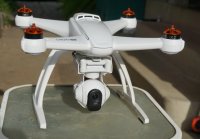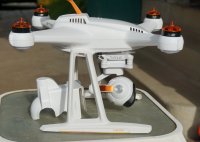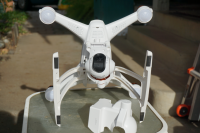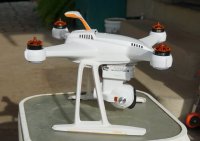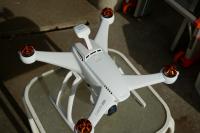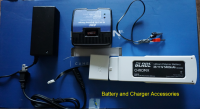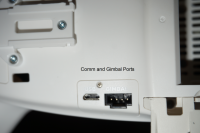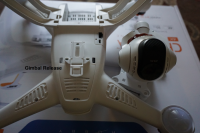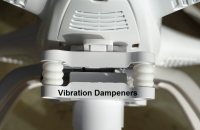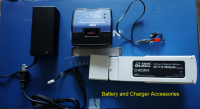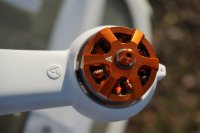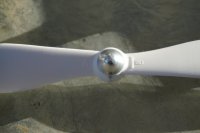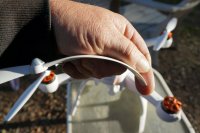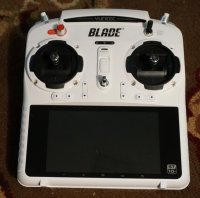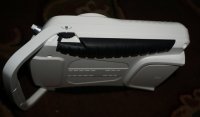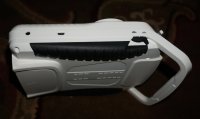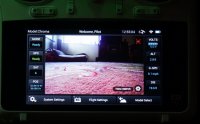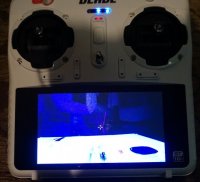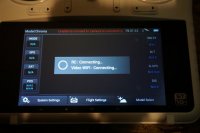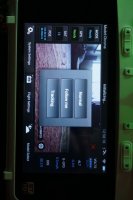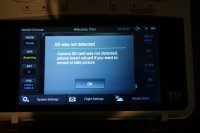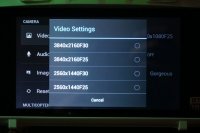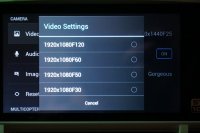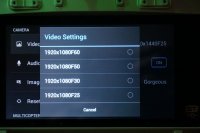Old Man
Active Member
Folks,
This is a consumer review of another consumer drone. No manufacturer or distributor contributed anything to the creation of this review, the entire system was bought and paid for on my own. I have no personal or professional association with Horizon or Yuneec, so this is totally independent and unbiased with the exception of personal likes and dislikes, which will be noted. This review is a work in progress so I'll be adding photos and videos as I have time to get them done. For a quick pictorial description of the Chroma and some of its features click the link for the usual information provided by distributors. http://www.horizonhobby.com/media/chroma/support.html
With all the consumer drones on the market, with more popping up every day, I decided it might be nice to have something I could toss or keep in the vehicle for quick use but without a lot of set up work. For those that might suggest I should have looked at a DJI product, please don't go there. I have a long standing beef with those guys and don't have any desire to go into that debate again. However, I did consider, very briefly considered, the Phantom 3, the 3DR Solo, the Yuneec Q-500+/Typhoon, and the Chroma CGO2 in 1080p and the Chroma CGO3 in 4k. Walkera was never in the running. Both the CGO2 and CGO3 use the same ST-10 transmitter, which has a video screen to display the camera view. The Chroma can be obtained RTF or in bind and fly format if you have a desire to use your own transmitter.
I eliminated any unit that required an additional iOS or Android device for operation to keep expense and complexity to a minimum. Another item that rode high on my list of desirables was/is customer service. That alone almost put the Solo back in contention but higher price, lack of gimbal inclusion, combined with the need for a separate control device put it out of the running. Horizon has always had pretty good customer service and by all reports over the last year or so Yuneec has been extremely responsive to product issues and customer inquiries. Final choice went to the Chroma CGO3 in 4k. The Typhoon almost made it but it's too slow, is larger than the Chroma, and has shorter flight times because of the additional size and weight. However, the Typhoon does provide more user flexibility in FC programming. Note that although made by Yuneec, Horizon Hobby is the dealer/distributor for the Chroma. You can not purchase it from Yuneec.
If this review sparks a desire to purchase a Chroma there are two things that one needs to do before making the purchase. The first is to visit the Horizon website and download the Chroma GUI and RAR file that's inside the GUI download. The second is to visit www.knowchroma.com and download the light code sheet. Like other makers, Yuneec makes heavy use of LED's light codes. Each of the 4 arms on the Chroma has a single light lens on the bottom of the arms and their colors are indicative of the state the system is in. You will also need to have a laptop or tablet that has USB ports, and have web connectivity when making the first connection between the MR and the system. You'll need the internet to review the short instructional videos at "knowchroma" that will answer some of the start up questions you'll undoubtedly have.
Important!
Something I cannot stress enough is for the new user to the Chroma (or any other copter) to take the time to read the instructions, fully explore the contents of the box it arrives in, and review the numerous videos at manufacturer sites and You Tube referencing operation. You cannot ever know enough and to buy it and try to immediately fly it is tantamount to certain disaster. Get to know the basics before setting out on your first aerial adventure.
The Chroma has extremely broad functionality in many aspects of its design and programming and you cannot possibly recognize many of them without looking further than what's in the box. Failure to explore and increase your knowledge base puts you at a severe disadvantage.
This is a consumer review of another consumer drone. No manufacturer or distributor contributed anything to the creation of this review, the entire system was bought and paid for on my own. I have no personal or professional association with Horizon or Yuneec, so this is totally independent and unbiased with the exception of personal likes and dislikes, which will be noted. This review is a work in progress so I'll be adding photos and videos as I have time to get them done. For a quick pictorial description of the Chroma and some of its features click the link for the usual information provided by distributors. http://www.horizonhobby.com/media/chroma/support.html
With all the consumer drones on the market, with more popping up every day, I decided it might be nice to have something I could toss or keep in the vehicle for quick use but without a lot of set up work. For those that might suggest I should have looked at a DJI product, please don't go there. I have a long standing beef with those guys and don't have any desire to go into that debate again. However, I did consider, very briefly considered, the Phantom 3, the 3DR Solo, the Yuneec Q-500+/Typhoon, and the Chroma CGO2 in 1080p and the Chroma CGO3 in 4k. Walkera was never in the running. Both the CGO2 and CGO3 use the same ST-10 transmitter, which has a video screen to display the camera view. The Chroma can be obtained RTF or in bind and fly format if you have a desire to use your own transmitter.
I eliminated any unit that required an additional iOS or Android device for operation to keep expense and complexity to a minimum. Another item that rode high on my list of desirables was/is customer service. That alone almost put the Solo back in contention but higher price, lack of gimbal inclusion, combined with the need for a separate control device put it out of the running. Horizon has always had pretty good customer service and by all reports over the last year or so Yuneec has been extremely responsive to product issues and customer inquiries. Final choice went to the Chroma CGO3 in 4k. The Typhoon almost made it but it's too slow, is larger than the Chroma, and has shorter flight times because of the additional size and weight. However, the Typhoon does provide more user flexibility in FC programming. Note that although made by Yuneec, Horizon Hobby is the dealer/distributor for the Chroma. You can not purchase it from Yuneec.
If this review sparks a desire to purchase a Chroma there are two things that one needs to do before making the purchase. The first is to visit the Horizon website and download the Chroma GUI and RAR file that's inside the GUI download. The second is to visit www.knowchroma.com and download the light code sheet. Like other makers, Yuneec makes heavy use of LED's light codes. Each of the 4 arms on the Chroma has a single light lens on the bottom of the arms and their colors are indicative of the state the system is in. You will also need to have a laptop or tablet that has USB ports, and have web connectivity when making the first connection between the MR and the system. You'll need the internet to review the short instructional videos at "knowchroma" that will answer some of the start up questions you'll undoubtedly have.
Important!
Something I cannot stress enough is for the new user to the Chroma (or any other copter) to take the time to read the instructions, fully explore the contents of the box it arrives in, and review the numerous videos at manufacturer sites and You Tube referencing operation. You cannot ever know enough and to buy it and try to immediately fly it is tantamount to certain disaster. Get to know the basics before setting out on your first aerial adventure.
The Chroma has extremely broad functionality in many aspects of its design and programming and you cannot possibly recognize many of them without looking further than what's in the box. Failure to explore and increase your knowledge base puts you at a severe disadvantage.
Last edited by a moderator:

